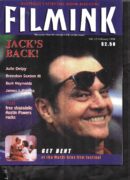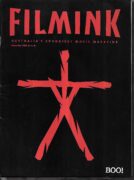
FilmInk: surviving on screen

In the digital age, a year in publishing equates to an elephant’s year in the jungle.
Translated to human years that means that the Australian cinema magazine, FilmInk, is the old bull in the stalls.
Beginning in 1997, during the heyday of free street press publishing, FilmInk has since undergone a number of reinventions to keep itself relevant in a rapidly evolving media landscape.
Deftly steering the publication from the beginning is Dov Kornits, FilmInk’s co-founder and publisher.

“There were Australian magazines such as Movie and Cinema Papers and there was an opening for a prosumer magazine like the American Premier, and I thought that we could do an Australian version of that as there was nothing like it in the market that’s from an Australian perspective,” Dov Kornits, FilmInk said.
With its mix of international and local news on the latest productions and releases the magazine was initially a fortnightly before moving to retailing nationally through news agencies.
“We then had a conversation with Hoyts who wanted to provide their customers with something informing them of upcoming releases, and they were a great partner to have,” Kornits said.

“With our population being so low you do not always have a compelling business case, so partnering with Hoyts allowed us to print a huge number of copies that were read around Australia.”
When the deal with the cinema chain came to an end and the print world was shrinking, Kornits saw a lifeline in an app.
“There was an app in Wired magazine, and it installed really well through the iTunes Store, and then we partnered with Adobe and we did a digital version of the magazine,” Kornits said.

“Now we could play trailers and cool interactive things, but the digital economy was a bit of a false promise and the numbers didn’t stick.”
After around seven editions it was time to try something else again, so the answer was to drop the paywalll and and go to a free online edition.
“It was no longer a curated magazine that people read from cover to cover, it’s more like a hungry beast that we feed multiple times a day,” Kornits said.
“There are up to 10 new posts a day, ranging from reviews to TV shows, streaming to interviews with directors and actors or news stories that are relevant.

“We are more eclectic with our coverage now, in the print days you had to be selective because you were limited by the number of pages you were printing.”
FilmInk’s evolution to digital has meant that they are now also curating content for specific media platforms such as YouTube or TiKTok.
“The thing that stays consistent is the call to action. We don’t want to write about a short film unless there is the ability for the reader to be able to access the content,” Kornits said.
“We are always trying to be practical about what we write about.”
The online version has now expanded to cover the latest Australian and international movie news; features on everything from cinema in Las Vegas to interviews with stars such as Sigourney Weaver; and how gaming shapes movie characters and narratives.
Kornit puts the reach of the magazine’s contributors down to the contacts and credibility that the title earned during its early years as a print mag.
“It comes from the legacy of having a really well respected print magazine that now spills over into the online edition,” Kornits said.
FilmInk uses a network of stringers, such as English based film journalist James Mottram, to cover international and local film festivals and releases.
Throughout its long history FilmInk has always been a strong supporter of local productions and currently includes a feature story about Streets Of Colour which was shot in Mount Druitt.
“FilmInk will support a lot of films that won’t get mainstream attention,” Kornits said.
Kornits is also co-producer of the Inner West Film Festival.
www.filmink.com.au









